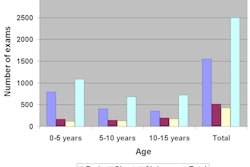
NEW YORK (Reuters Health), Oct 28 - When rheumatoid arthritis (RA) is in clinical remission yet structural deterioration continues, the cause appears to be subclinical joint inflammation (synovitis) that can be detected by ultrasound and by MRI, according to a prospective longitudinal study by U.K. and U.S. researchers published in the October issue of Arthritis & Rheumatism.
The study is reportedly the first to show both this direct association and to demonstrate that subclinical inflammation can predict later results by x-ray examination of clinically asymptomatic joints.
This study used the same cohort of patients who had participated in an earlier phase of the study, published in 2006. In that phase, the authors had established that even though most of the patients fulfilled standard criteria for RA remission, and all were receiving disease-modifying antirheumatic drugs (DMARDs), sizable majorities of the patients showed synovial inflammation when imaged with ultrasound or MRI.
In the current analysis, 90 participants underwent x-rays of hands, wrists, and feet, as well as MRI and ultrasound assessments of the dominant hand and wrist, at baseline and then 12 months later.
The patients had a mean age of 57 years, two-thirds were female, and 91% were taking DMARDs. At baseline, median disease duration was seven years and median remission was almost two years.
During the 12-month study period, there were no statistically significant changes in measures of RA activity; that is, all patients were still considered to be in remission, senior researcher Dr. Paul Emery at the University of Leeds, U.K., and colleagues report.
Despite being in remission, 17 of the 90 patients experienced an overall increase (p = 0.001) in their radiographic joint damage scores. In addition, baseline scores as determined by the more sensitive imaging methods were significantly associated with the likelihood of subsequent structural deterioration in the metacarpophalangeal joints.
The results, write the researchers, "suggest that, in the majority of RA patients who are treated with conventional DMARDs, joint damage is closely related to subclinical inflammation, which in states of low disease activity, can only be accurately detected by imaging techniques such as musculoskeletal ultrasound and MRI."
The authors suggest that the threshold for additional intervention in such patients might need to be lowered, since they could benefit from additional therapy even when RA activity is low.
Emery told Reuters Health that barriers to wider use of ultrasound and MRI in assessing subclinical manifestations of RA include cost and training requirements, as well as access.
By Scott Baltic
Arthritis Rheum 2008;58:2958-2967.
Last Updated: 2008-10-27 15:25:54 -0400 (Reuters Health)
Related Reading
Power Doppler ultrasound accurately tracks rheumatoid arthritis treatment response, October 1, 2008
Copyright © 2008 Reuters Limited. All rights reserved. Republication or redistribution of Reuters content, including by framing or similar means, is expressly prohibited without the prior written consent of Reuters. Reuters shall not be liable for any errors or delays in the content, or for any actions taken in reliance thereon. Reuters and the Reuters sphere logo are registered trademarks and trademarks of the Reuters group of companies around the world.

















